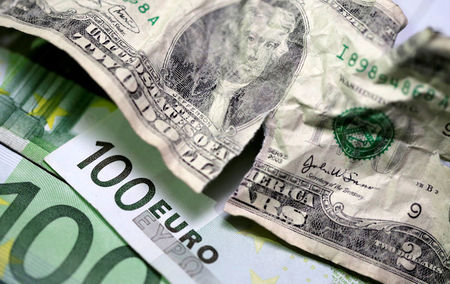
Investing.com – The U.S. dollar slipped lower in early European trade Monday ahead of the week’s key employment report, while the euro rallied after the first round of voting in the French elections.
At 05:30 ET (09:30 GMT), the Dollar Index, which tracks the greenback against a basket of six other currencies, traded 0.3% lower at 105.255, around a one-week low.
Dollar slips ahead of payrolls release
The dollar index has been hit by the strength of the euro Monday, with the single currency carrying the largest weight in the basket, but it was already on the back foot after Friday’s release of softer than expected inflation data.
The Federal Reserve’s preferred inflation measure, the personal consumption expenditures (PCE) index, showed a cooling in inflation on Friday, raising expectations that the U.S. central bank will begin cutting interest rates later this year.
Attention in this U.S. holiday-shortened week, with Thursday celebrated as Independence Day, will largely be on Friday’s nonfarm payrolls report as traders look for fresh indications on when the Fed might start to cut interest rates.
Economists are expecting the U.S. economy to have added 189,000 jobs in June after a larger than forecast gain of 272,000 the previous month.
Ahead of the nonfarm payrolls data, a report on Tuesday is expected to show that job openings declined again in May, Wednesday sees the release of the minutes of the Fed’s June meeting, and Fed Chair Jerome Powell is to make an appearance at the European Central Bank’s annual forum in Portugal.
Euro gains after first round of French elections
EUR/USD rose 0.5% to 1.0765, around a two-week high, after a win by the French far right in the first round of parliamentary elections fell slightly short of some expectations.
Marine Le Pen’s far-right National Rally party won the first round of France’s parliamentary elections on Sunday, claiming 33% of the national popular vote.
The leftwing New Popular Front came in second with 28%, while President Emmanuel Macron’s centrist bloc reached 20%.
The margin of National Rally’s win was tighter than expected, leaving the final result dependent on party deals before the weekend’s second round.
“First round results are not offering much certainty about the composition of the parliament, and the second round scheduled for the next weekend is in fact the big risk event,” said analysts at ING, in a note.
This political news has overshadowed data showing manufacturing activity across the eurozone took a turn for the worse last month as demand fell at a much faster pace despite factories cutting their prices.
GBP/USD rose 0.3% to 1.2673, with sterling rising despite data showing British manufacturing activity growth slowed in June from the previous month.
S&P Global’s UK Manufacturing Purchasing Managers’ Index dropped to 50.9 in June from 51.2 in May, with the final reading lower than 51.4 in the provisional data.
The U.K. general election takes place on Thursday, with the opposition Labour Party widely expected to win the keys to Downing Street.
“There has, indeed, been very little doubt about a Labour landslide win, so the election should not be a huge event for markets. We suspect that a stronger than expected result by populist/hard-Brexiteer Reform UK is the most tangible risk for some slight adverse reacting in GBP assets,” ING said.
Yen remains weak
In Asia, USD/JPY traded 0.1% higher to 161.02, remaining near its weakest levels in 38 years.
The Japanese government on Monday unexpectedly revised first-quarter gross domestic product data, with the reading now showing a much deeper contraction than initially expected.
The reading presented a dour outlook for the Japanese economy, and also raised doubts over just how much headroom the Bank of Japan has to begin tightening policy.
USD/CNY edged marginally higher to 7.2683, sticking close to levels last seen in November.
Purchasing managers index data painted a mixed picture of the economy. Government PMI data on Sunday showed China’s manufacturing sector shrank for a second straight month in June, but private PMI data showed the sector growing at its fastest pace in three years.
This post is originally published on INVESTING.


